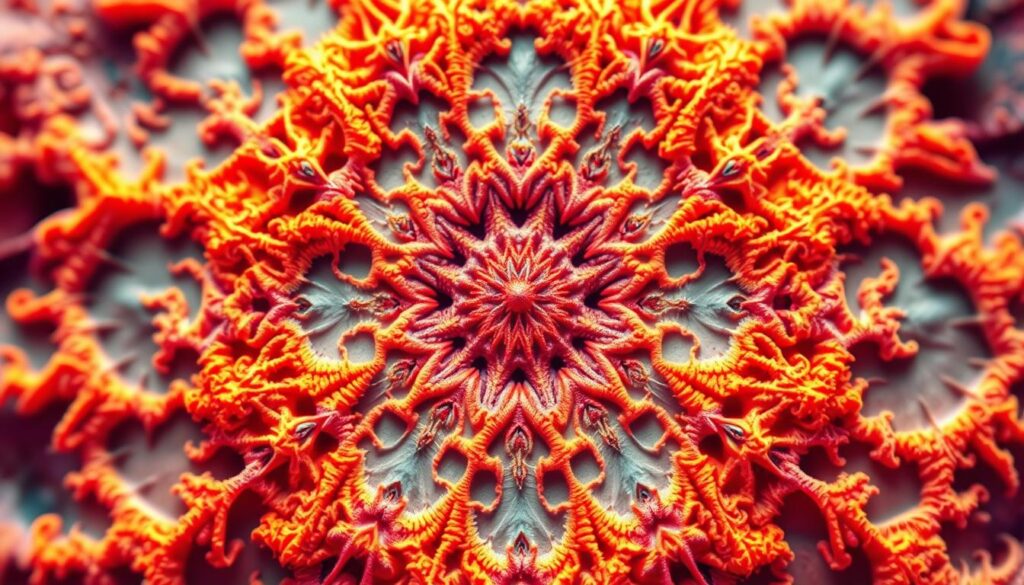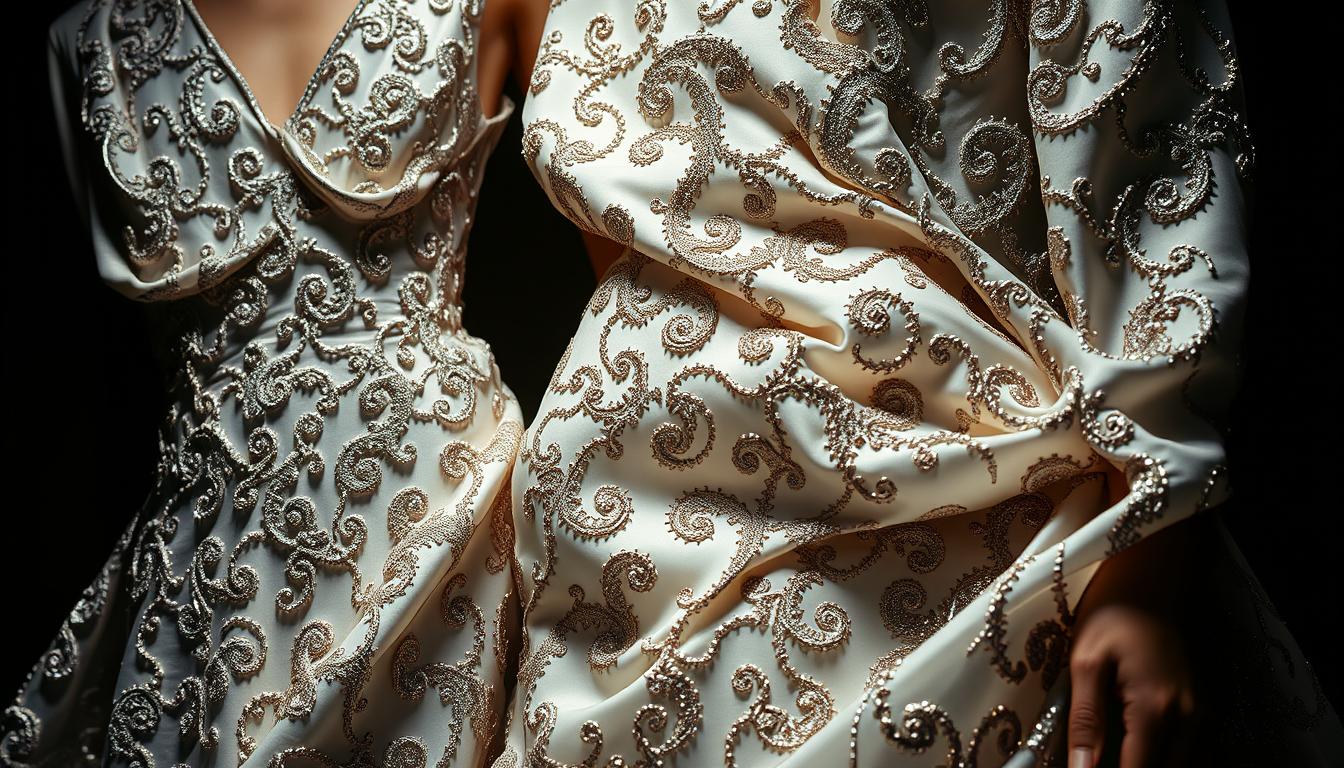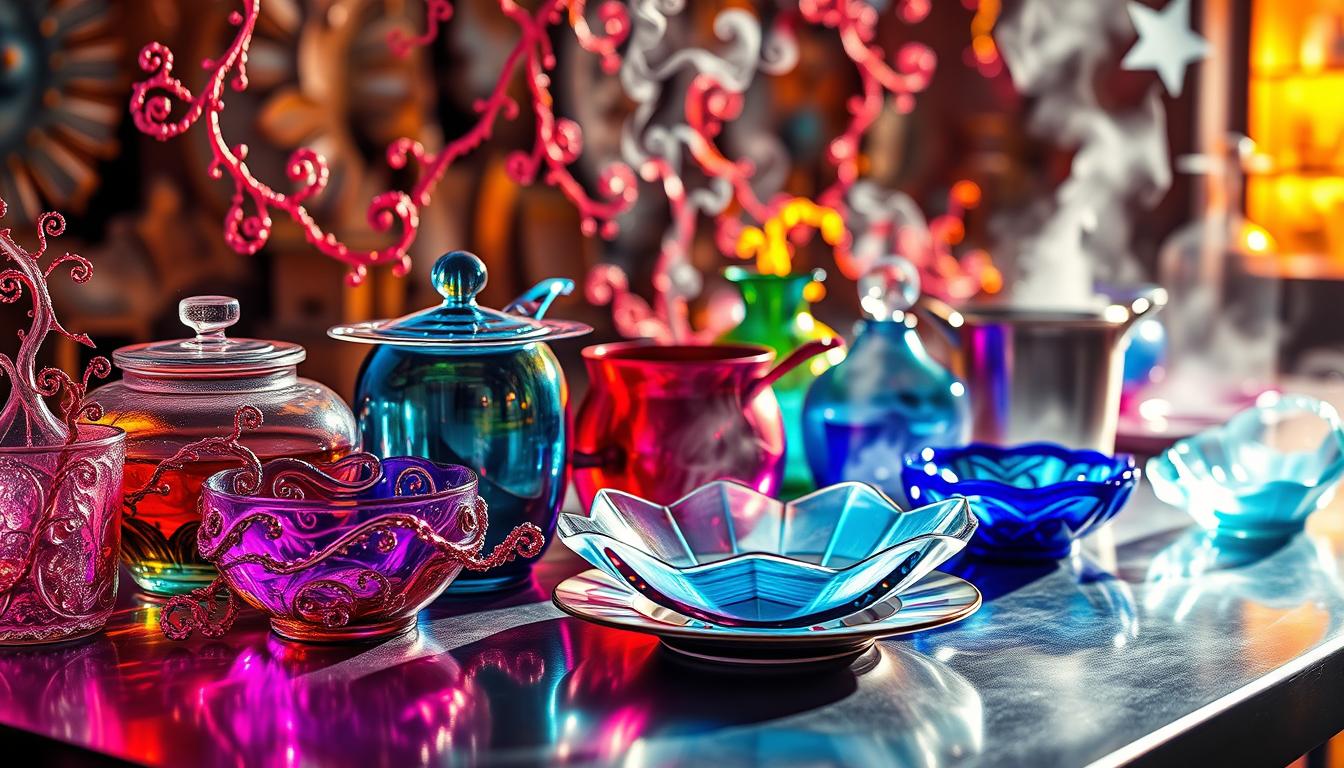Diving into how fractals and psychology come together opens up amazing insights. These complex patterns affect our behavior and cognition. Fractals do more than please the eye; they bring new ways to boost our mental well-being.
Using fractal designs in therapy and our daily spaces can help lessen anxiety and improve our thinking. This part explains how fractal patterns’ beauty can change our mental world.
Understanding Fractals: A Brief Overview
Fractals are amazing shapes with detailed and beautiful designs. They follow a fractal definition. These shapes are known for self-similarity, meaning they repeat patterns at different sizes. This repeating nature helps us understand their role in many natural occurrences.
Many patterns in nature show fractal traits. For instance, coastlines have jagged edges, trees spread their branches widely, and leaves display complex patterns. Each example shows how a smaller part can look like the whole thing. This is what we call self-similarity.
People love studying fractals because they look so appealing. Studies show we’re naturally attracted to these detailed shapes. They connect with our deep love for nature’s beauty. Not only do they grab our attention, but they also touch our emotions. This makes fractals very important in psychology and art.

The Mathematical Foundation of Fractals
Fractals bring a big change to mathematics by showing how complex patterns work. They were mainly explored by Benoît Mandelbrot. He found shapes that look similar at any size, which was new compared to old geometry.
This new idea was about shapes not fitting the usual dimensions. The term “fractal dimension” or D-value measures how these patterns shrink. It shows fractals are more complex than normal shapes.
Unlike classic geometry, fractal geometry can describe many natural and scientific phenomena. It’s useful in physics, biology, and economics. Benoît Mandelbrot’s work changed how we use math to see the world around us.
The Connection Between Fractal Patterns and Nature
Natural fractals show the beauty in the world around us. They link to the patterns in ecology. We see these patterns in tree branches and river networks. They show nature’s beauty and complexity.
Our love for nature makes us appreciate fractals. They can make us feel calm and happy. Studies say being around fractals makes us feel peaceful.
Using fractals in design can make spaces better. They are pretty and help us feel close to nature. This helps architects create places that are good for our minds and hearts.
Fractals and Psychology: Implications for Behavior and Cognition
Fractals have a big impact on how we see things and think. They make our emotional reactions stronger. This is because of their complex patterns. These patterns can make us think deeply and feel more connected.
The Role of Fractals in Visual Perception
Fractals catch our eye in a special way. Our love for complex designs comes from nature. This love makes our visual experience richer.
People feel more relaxed and happy when they see fractals. The mix of excitement and calm these patterns bring is important. It helps us feel better mentally.
Fractals and Cognitive Processing
Fractals make it easier for us to recognize patterns. Their structured yet varied look improves how we process information. This doesn’t make us overwhelmed but helps sharpen our focus.
Looking at fractal art can make us think and feel more clearly. Finding patterns in fractals comforts us psychologically. It makes us feel at ease and familiar with our surroundings.
Aesthetic Appeal of Fractals in Human Experience
People are intrigued by fractals not just because of math. They find them beautiful in art. Artists use these complex patterns to delight viewers. These patterns are both similar in parts and complex overall. They make us feel good and bring visual pleasure.
Studies show we naturally like fractal designs. They remind us of beauty and order. This makes us enjoy art with fractals more. Artists from the past and today use fractals. You can see these patterns in paintings, sculptures, and digital art.
Fractals help us see the world in a special way. Their use in buildings can make us feel better. Architects and designers are adding fractals to their work. This brings peace and beauty to spaces. It shows how what we see affects how we feel inside.
Fractals and Stress Reduction in Environments
Fractals play a big role in making environments better, especially for lowering stress. Using fractal patterns in buildings and outdoor designs helps create calm places. This can improve mental health. It does so through biophilic design that helps us feel connected to nature.
Biophilic Design and Fractals
Biophilic design blends natural elements, like fractal patterns, into spaces where we feel good. Studies show these spaces can really cut down on stress. They do this by making us feel closer to nature, even in cities. This design offers several perks:
- Improved mood and reduced anxiety
- Enhanced cognitive function and focus
- Creation of a peaceful atmosphere conducive to relaxation
By adding fractals to design, spaces become peaceful and help us focus. Natural designs make stress go down a lot. This makes life better for people who use these spaces. It shows why we should use biophilic design in modern buildings and city planning.
The Impact of Fractals on Mental Wellbeing
Fractal patterns are key to boosting mental health and wellness. Seeing these complex designs can help our brains work better and make us feel happier. Studies show that fractal-rich places can lower stress and anxiety, bringing peace in many situations.
In places like hospitals and healing spaces, fractal designs are used to calm patients. They help create a peaceful environment, aiding in recovery and relaxation. The benefits of fractals for mental health include:
- Reduction in anxiety and stress levels
- Increased mental clarity and focus
- Enhanced overall emotional well-being
When we interact with fractals, our mind reacts in positive ways. Engaging with these patterns can improve our brain’s function, making it easier to think and make decisions. Fractals aren’t just nice to look at; they’re also a potent tool for better mental health and healing.
Fractal Patterns in Art and Therapy
Fractal patterns are important in art therapy and healing. They offer new ways for people to express themselves and recover. These designs catch the eye and stir emotions, helping people connect better during therapy.
Fractals in therapy settings can make people more engaged. Their repeating, yet unique, patterns help folks dive into their emotions and creativity. This makes the healing process more interactive through visual means.
Art therapists use fractals to encourage clients to create and reflect. This not only heals but also builds confidence and self-knowledge. It’s a key part of therapy. Using fractals in art therapy increases its impact, aiding in mental health support.
Fractal Therapy: Applications and Benefits
Fractal therapy is the meeting point of psychology and rehabilitation. It uses patterns from nature to help improve mental health. By focusing on fractals, this therapy aims to boost brain flexibility. This is helpful for people with cognitive issues or brain disorders.
In treatment, doctors use fractal images in their sessions. Patients look at these fractal patterns on screens or in print. These complex patterns, similar to those in nature, grab and hold a person’s attention, improving their brain’s processing power. Fractals’ unpredictable yet rhythmic nature can also help people relax, which is vital for recovery.
The research points out fractal therapy’s main uses:
- Boosting brain power after a stroke
- Bettering focus and memory in those with brain conditions
- Easing anxiety and stress with calming fractal pictures
Fractal therapy helps create new brain connections, highlighting the power of neuroplasticity. When people interact with these patterns, their brains can reshape and adjust. This can improve mental tasks and emotional well-being during rehab.
Research Findings on Fractals and Cognitive Function
Recent studies point out how fractals affect our minds. They show that fractals can boost our attention, memory, and emotions. Seeing fractal patterns helps people focus better and perform well in tasks that need long-term attention.
Neuropsychology shows us more about how fractals work on our brains. It finds that people who spend time with fractals can think more flexibly. They get better at learning new things and making decisions because they can adjust to new info faster.
These studies also tell us fractals make us feel something special. Their complex patterns can make us feel calm and curious at the same time. This feeling helps us learn better. Looking at fractals can also make us appreciate beauty more and clear our minds.
Conclusion
Fractals and psychology are closely linked, shaping how we think and act. These patterns are not just interesting to look at. They also make us feel better and understand our world more. As we see fractals, our brains get a nice boost, helping us grasp our surroundings better.
Bringing fractals into fields like design, therapy, and education matters a lot. They catch our eye and help us feel calm and focused. This can lead us to a happier and healthier mind. Looking ahead, we need to explore more about how fractals can play a role in psychology. This could lead to better ways to help people through design and therapy.
The journey of combining fractals with psychology is filled with possibilities. It shows us new ways to support mental health. By appreciating fractals’ complexity and beauty, we might find fresh strategies to enhance our mental well-being. This could transform how we design spaces and therapies, touching our minds and hearts.



